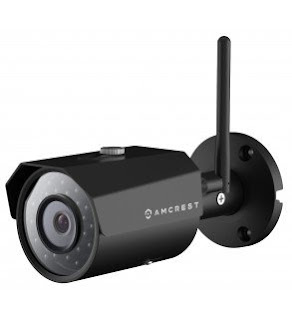Wifi Security Cameras
Wifi security cameras are security cameras that send video and audio signals to a receiver using radio band. These security cameras come with inbuilt transmitters that take care of the transmission. This makes wires entirely unnecessarily.
The radio transmitted on security cameras sends the audio and video to a receiver that is connected to a recording monitor and device. Some receivers have inbuilt storage which stores images and videos for any later viewing. Cloud storage options are also available for these cameras as they are readily connected to the internet.
Contradictory to what you may think, some wifi security camera still need a wire for their power source. Some cameras, however, use batteries for power, thus, making them wireless.
Wireless cameras are very useful when you do not wish to run long video and audio cables around the area you need under surveillance. With such features, installation is less expensive when compared to wired security cameras since you work with very few wires. There are times when laying down the cables is not an option, such as in historical places, museums, and other occasional sites. The cameras are a better option when you want to watch over several buildings.
In this article, the author will focus on different types of wifi security cameras:
Plug in or Battery Operated
There are security cameras that rely on the power source and those that use batteries. Wifi cameras that plug into a power outlet do not have to be recharged or have the battery changed. This prevents a footage from not recording due to low powered batteries. However, it would be impractical to put a crucial area under surveillance with a power outlet near the camera. The better option in such cases would be a battery operated security camera.
2.4 GHz or 5.8 GHz WiFi Cameras
One classification of wifi cameras makes use of the frequency they broadcast. The frequency can be 2.4 GHz and 5.8 GHz cameras. Both cameras can handle analog and digital video, but the 2.4 GHz camera has a range of around 750 feet and handles up to four transmissions. On the other hand, a 5.8 GHz security camera, has a range of around 2,500 feet and can carry up to eight transfers. Since only a few devices are on this frequency, less interference is always encountered.
Cellular Security Cameras
Cellular cameras are wireless cameras that include a cell transmitter and connect to a mobile carrier network to transmit videos. They are not different from other cameras, but their reality may be affected by network conditions. A major downside of these cameras is that they may prove to be very expensive in the long run. For some, these are the best solution as it does not rely on any broadband system.
Analog and Digital Cameras
These are two types of transmission that can occur on a Radio Frequency Transmitter. Analog cameras send a steady stream of data and make the communication vulnerable to be intercepted. For digital wifi security cameras, they work by modulating their signals and cycling through different frequencies to help in avoiding interference. It is more secure as it needs to be paired with a receiver before the latter can pick audio and video feeds.
Before making an important decision of installing security camera systems, it is good to be equipped with complete knowledge about them. This helps in making an informed decision and choosing the camera that fulfills your expectations and needs.




Comments
Post a Comment